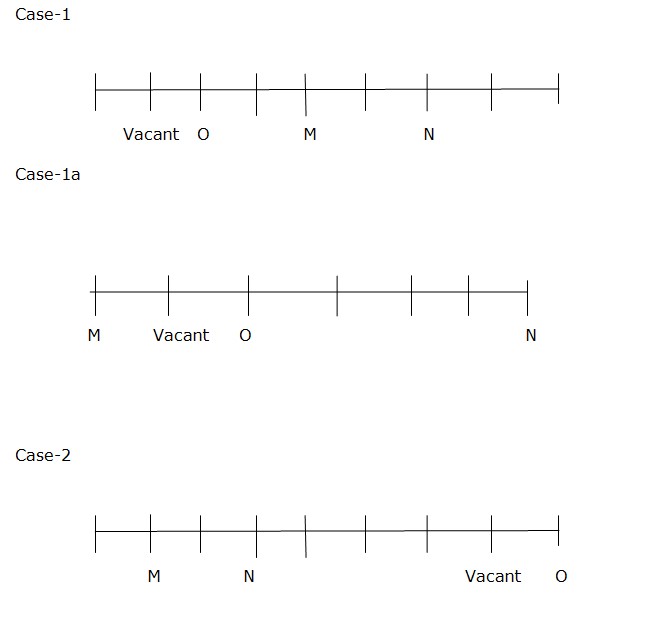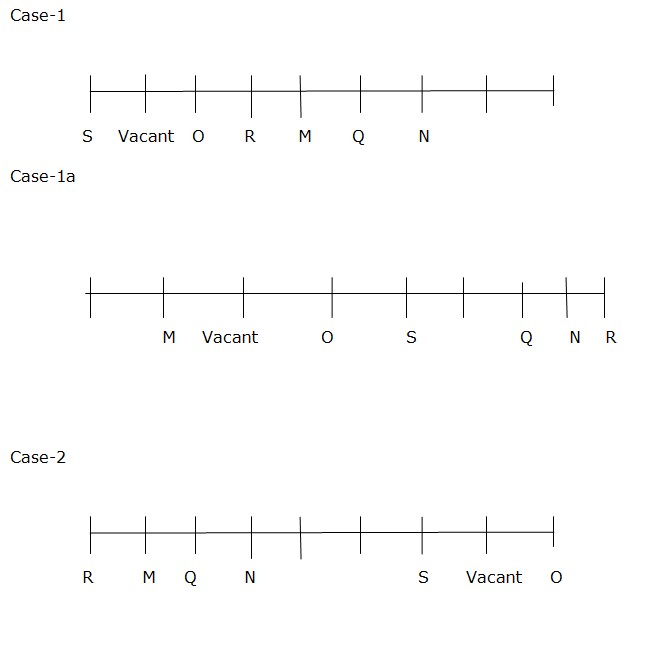Question
Which of the following statement is true?
Study the following information carefully and answer the questions given below. Eight friends – M, N, O, P, Q, R, S, and T, are seating on nine seats in a straight line at an equal distance but not necessarily in the same order. One seat in the row is vacant. All of them are facing north directions. There are three persons sit between O and N. The person who sits two places away from N sits fourth to the right of M. M sits neither adjacent to O nor adjacent to S. The person who sits immediate left of the vacant seat sits two places away from O. Q does not sit adjacent to O. R sits two places away from Q. The number of persons who sits between N and R is one less than the number of persons who sits between S and Q. M does not sit at the end. T sits adjacent to N. The number of persons who sits between Q and P is same as the number of persons who sits between T and O. Q does not sit right of N.Solution
There are three persons sit between O and N. The person who sits two places away from N sits fourth to the right of M. M sits neither adjacent to O nor adjacent to S. The person who sits immediate left of the vacant seat sits two places away from O.  Q does not sit adjacent to O. R sits two places away from Q. The number of persons who sits between N and R is one less than the number of persons who sits between S and Q. M does not sit at the end. Q does not sits right of N.
Q does not sit adjacent to O. R sits two places away from Q. The number of persons who sits between N and R is one less than the number of persons who sits between S and Q. M does not sit at the end. Q does not sits right of N.  T sits adjacent to N. This eliminates case 1a. The number of persons who sits between Q and P is same as the number of persons who sits between T and O. This eliminates case 1 and 1a. so final case-2 Case-2
T sits adjacent to N. This eliminates case 1a. The number of persons who sits between Q and P is same as the number of persons who sits between T and O. This eliminates case 1 and 1a. so final case-2 Case-2 
Which of the following information is/are TRUE with respect to the changes made by the Reserve Bank of India in relation to the Small Finance Banks ?
On which expressway project did Uttar Pradesh set two world records in 24 hours?
What is the daily limit for Person-to-Person (P2P) transfers under UPI?
What was the rate of microfinance loans overdue by more than 30 days in FY 2024–25, according to Sa-Dhan data?
Which of the following statements about Mumbai and Delhi being among the world's wealthiest cities are correct?
A) Mumbai ranks 24th and Delhi ra...
Which festival was celebrated in Tripura with the ‘Garia and Borsho Boron Utsav’ 2025?
SEBI has approved amendments to the SEBI(Infrastructure Investment Trusts) Regulations, 2014 and SEBI (Real Estate Investment Trusts) Regulations, 201...
What is the theme of the Youth Spiritual Summit 2025 scheduled in Varanasi?
The Safai Apnao Bimaari Bhagao initiative under SBM-U 2.0 focuses on which of the following?
Who has been appointed as the Secretary (at the Director level) of the National Jute Board in Kolkata?
Relevant for Exams:



